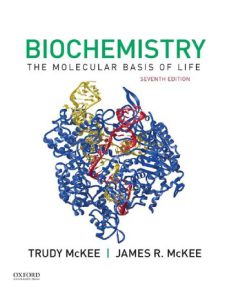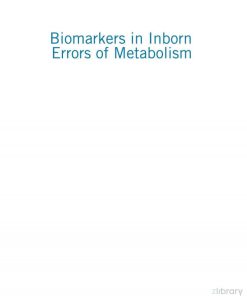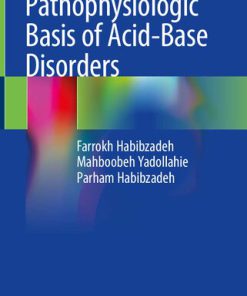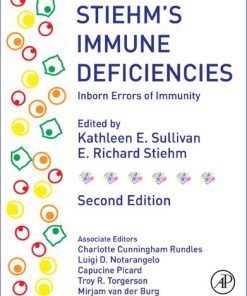Epstein’s inborn errors of development : the molecular basis of clinical disorders of morphogenesis 3rd Edition by Erickson 0190275421 9780190275426
$50.00 Original price was: $50.00.$25.00Current price is: $25.00.
Epstein’s inborn errors of development : the molecular basis of clinical disorders of morphogenesis 3rd Edition by Erickson – Ebook Instant Download/Delivery ISBN(s): 0190275421, 9780190275426
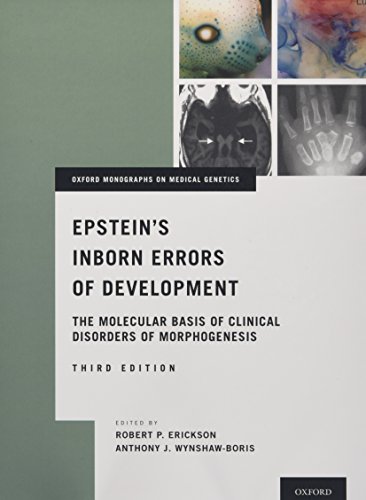
Product details:
- ISBN 10: 0190275421
- ISBN 13: 9780190275426
- Author: Erickson
This third edition of Epstein’s Inborn Errors of Development provides essays on pathways of development and thoughtful reviews of dysmorphic syndromes for which the causative gene has been identified. The authors of the chapters on each disorder have provided in depth analyses of the role of the gene in the relevant developmental pathway and the mechanism by which mutations in the gene cause the developmental pathology.
Table of contents:
I. GENERAL CONCEPTS
1. Human Malformations and Their Genetic Basis
2. Principles of Differentiation and Morphogenesis
3. Model Organisms in the Study of Development and Disease
4. Human Genomics and Human Development
II. Patterns of Development
5. Development of Left-.Right Asymmetry
6. Neural Crest Formation and Craniofacial Development
7. Development of the Nervous System
8. Development of the Eye
9. Development of the Ear
10. Molecular Regulation of Cardiogenesis
11. Update on the Development of the Vascular System and Its Sporadic Disorders
12. Muscle and Somite Development
13. The Development of Bone and Cartilage
14. Limb Development
15. The Sex-.Determination Pathway
16. Development of the Kidney
17. Development of the Endodermal Derivatives in Lung, Liver, Pancreas, and Gut
18. Development of Epidermal Appendages: Teeth and Hair
III. Defined Core Developmental Pathways Linked to Cilia
A: Ciliary Functions: Genesis, Transport, and Reabsorbtion
19. Primary Ciliary Dyskinesia (Kartagener Syndrome)
20. The Molecular Basis of Joubert Syndrome and Related Disorders
21. The Bardet-.Biedl Syndrome
22. The Molecular Basis of Oral-.Facial-.Digital Type I Syndrome
23. Meckel Syndrome
24. From Hydrolethalus to Acrocallosal Syndromes: A Spectrum of Disorders Linked to the KIF7 Gene
25. Sensenbrenner Syndrome (Cranioectodermal Dysplasia, CED): A Genetically Heterogeneous Ciliopat
26. MKKS and the McKusick-.Kaufman and Bardet-.Biedl Syndromes
B: The Sonic Hedgehog Signaling Pathway
27. The Hedgehog Signaling Network
28. Smith-.Lemli-.Opitz Syndrome
29. SHH and Holoprosencephaly
30. IHH, Acrocapitofemoral Dysplasia, and Brachydactyly A1
31. PTCH and the Basal Cell Nevus (Gorlin) Syndrome
32. GLI3 and the Pallister–.Hall and Greig Cephalopolysyndactyly Syndromes
33. SALL1 and the Townes-.Brocks Syndrome
34. MYCN and Feingold Syndrome
35. Preaxial Polydactyly Type 2 and Associated Limb Defects
C: The Wnt Signaling Pathway
36. The Wnt Signaling Pathway
37. AXIN2, Tooth Agenesis, and Colorectal Cancer
38. WNT3 and Tetra-.Amelia
39. ROR2, Brachydactyly Type B, and Recessive Robinow Syndrome
40. Cenani-.Lenz Syndrome
41. Goltz Syndrome (Focal Dermal Hypoplasia)
42. WNT10A and Odonto-.Onycho-.Dermal Dysplasia
43. Al-.Awadi-.Raas-.Rothschild Syndrome/.Fuhrmann Syndrome
44. AXIN1 and Caudal Duplication Anomaly
D: The Planar Cell Polarity (PCP) Pathway
45. Role of Planar Cell Polarity Genes VANGL1 and VANGL2 in Neural Tube Formation and Neural Tube De
IV. Other Defined Core Developmental Pathways
A: The TGF-.ß Signaling Pathway
46. An Introduction to TGF-.ß Family Signaling
47. NOG and Proximal Symphalangism (SYM1), Multiple Synostosis (SYN1), Tarsal-.Carpal Coalition, an
48. Nodal Signaling and Heterotaxy
49. ENG, ACVRL1, SMAD4, and Hereditary Hemorrhagic Telangiectasia (Osler-.Weber-.Rendu Syndrome)
50. RUNX2 and Cleidocranial Dysplasia
51. AMH/.MIS and Its Receptors: The Persistent Müllerian Duct Syndrome
52. LEMD3 and Osteopoikilosis, the Buschke-.Ollendorff Syndrome and Melorheostosis
53. TGFBR 1/.2 and Loeys-.Dietz Syndrome
54. ZEB2 and Mowat-.Wilson Syndrome
55. LTBP4 and Autosomal Recessive Cutis Laxa Type IC
56. ACVR1 and Fibrodysplasia Ossificans Progressiva
57. The Role of the Latent TGF- ß Binding Protein 3, LTBP3, in Tooth, Spine, and Bone Density Abno
B: The TNF Signaling Pathway
58. Signaling by TNF and Related Ligands
59. The Ectodysplasin Signaling Pathway in Hypohidrotic Ectodermal Dysplasias
C: The FGF Signaling Pathway
60. Molecular and Cellular Biology of FGF Signaling
61. FGF Receptor Mutations: Bone Dysplasia, Craniosynostosis, and Other Syndromes
62. FGF10, FGFR2, and FGFR3 and the Lacrimo-.Auriculo-.Dental-.Digital (LADD) Syndrome
63. TWIST1 and the Saethre-.Chotzen Syndrome
64. FGFR1, FGF8, PROKR2, PROK2, ANOS1, and the Olfactogenital (Kallmann) Syndrome
65. TIE2 (TEK) and Venous Malformation
66. FLT4 (VEGFR3) and Milroy Disease
67. Focal Facial Dermal Dysplasias
D: Glia Cell–.Derived Neurotrophic Factor Signaling
68. Signaling Pathways of Glial Cell–.Derived Neurotrophic Factor
69. RET Mutation and Function in HSCR, MEN2, and Other Cancers
E: Introduction to Endothelin-.B Receptor and SOX10 Pathways
70. Introduction to Endothelin-.B Receptor and SOX10 Pathways
71. EDNRB, EDN3, SOX10, and the Shah-.Waardenburg Syndrome (WS4)
F: The Notch Signaling Pathway
72. Introduction to Notch Signaling
73. JAG1 and NOTCH2 and the Alagille Syndrome
74. DLL3, MESP2, LFNG, HES7, TBX6, RIPPLY2 and Spondylocostal Dysostosis
G: The PI3K-.LKB1 Pathway
75. The PI3K-.LKB1 Pathway
76. PTEN and Cowden and Bannayan-.Riley-.Ruvalcaba Syndromes
77. STK11 (LKB1) and Peutz-.Jeghers Syndrome
78. TSC1, TSC2, and Tuberous Sclerosis
H: The RAS/.ERK/.MAPK Pathway
79. The RAS Pathway
80. Neurofibromatosis Type 1
81. Noonan Syndrome and RAS Signaling Defects
82. HRAS and Costello Syndrome
83. The Ras/.MAPK Pathway and the Cardio-.Facio-.Cutaneous Syndrome
84. RASA1 and Capillary Malformation–.Arteriovenous Malformation
85. SPRED1 and Legius Syndrome
I: Eph/.Ephrin Signaling
86. Introduction to Eph/.Ephrin Signaling in Vertebrate Development
87. Craniofrontonasal Syndrome and EFNB1 Mutations
V. Transcription Factors and Chromatin Regulators
A: The Homeobox Gene Family
88. The Role of Hox and Dlx Gene Clusters in Evolution and Development
89. HOXA1 Deficiency Syndrome
90. HOXA11 and Amegakaryocytic Thrombocytopenia With Radioulnar Synostosis
91. HOXA13 Hand-.Foot-.Genital Syndrome and Guttmacher Syndrome
92. HOXD10 Mutations Associated With Congenital Vertical Talus and Pes Cavus Claw-Toe Limb Abnormal
93. HOXD13 and Synpolydactyly
94. EMX2, HESX1, Type I Schizencephaly, and Septo-.Optic Dysplasia
95. PDX1, Pancreatic Agenesis, and Type 2 Diabetes
96. MSX1, Hypodontia, Orofacial Clefting, and the Witkop Syndrome
97. MSX2 in Craniosynostosis and Defects of Skull Ossification
98. SHOX, Dyschondrosteosis, and Turner Syndrome
99. HLXB9 (MNX1), Sacral Agenesis, and the Currarino Syndrome
100. Branchio-.Oto-.Renal (BOR) Syndrome
101. PITX2 and PITX3: Axenfeld-.Rieger Syndrome, Anterior Segment Dysgenesis, Posterior Polar Conge
102. and Congenital Heart Disease
103. LMX1B and the Nail-.Patella Syndrome
104. The ALX Homeobox Gene Family and Frontonasal Dysplasias
105. Simplex and Complex Microphthalmia Genes—.OTX2, RAX, VSX2, VAX1, SIX6, and HMX1
106. PRRX1
107. Developmental Abnormalities Due to Mutations in the Aristaless-.Related Homeobox Gene
108. PITX1-.Associated Congenital Lower Limb Malformations
B: The Paired Box (PAX) Gene Family
109. The Paired Box (PAX) Gene Family: Introduction to Paired. Box Genes
110. PAX2 and the Renal-.Coloboma Syndrome
111. PAX3 and Waardenburg Syndrome Type 1
112. PAX6, Aniridia, and Related Phenotypes
113. PAX9 and Hypodontia
C: The Forkhead Gene Family
114. Introduction to Forkhead Genes
115. FOXC1, FOXL2, the Axenfeld–.Rieger Syndrome, and the Blepharophimosis, Ptosis, and Epicanthus
116. FOXC2, FOXF1, and the 16q24.1-.Region Microdeletions: Lymphatic, Vascular, Cardiac, and Other
117. FOXE1: Bamforth-.Lazarus Syndrome, Thyroid Dysgenesis, and Thyroid Cancer Predisposition
118. AGGF1 and Vascular Disease: Klippel-.Trenaunay Syndrome
D: The T-.Box Gene Family
119. Introduction to the T-.Box Genes: Their Evolution and Roles in Development
120. The 22q11.2 Deletion Syndrome and TBX1
121. TBX3, TBX5, and the Ulnar-.Mammary and Holt-.Oram Syndromes
122. TBX22, X-.linked Cleft Palate, and Ankyloglossia
E: The SOX Gene Family
123. Sox Genes in Development and Disease
124. SOX2 and Malformations of the Eye, Brain, Foregut, and Male Genital Tract
125. SOX3 and Infundibular Hypoplasia
126. SOX9, Campomelic Dysplasia, and Sex Reversal
127. SOX18 and the Hypotrichosis-.Lymphedema-.Telangiectasia Syndrome
F: Transcription Factors
128. MITF and the Waardenburg Type II and Albinism-.Deafness (Tietz) Syndromes
129. POU3F4 and Mixed Deafness With Temporal Bone Defect (DFNX2)
130. Char and Branchio-.Oculo-.Facial Syndromes: The AP-.2 Transcription Factor Defects
131. GATA3, Hypoparathryoidism, Deafness, and Renal Disease
132. FOG-.2 (now ZFPM2), GATA-.4, Congenital Heart Disease, and Diaphragmatic Hernia
133. PTF1A: Pancreatic and Cerebellar Agenesis
134. RAI1, Smith-.Magenis Syndrome, and Potocki-.Lupski Syndrome
135. SALL4 and the Duane Radial-.Ray/.Okihiro and Acro-.Renal-.Ocular Syndromes
136. HNF1B-.MODY: A Disorder of Development With Diabetes and Congenital Malformations in the Panc
137. ZIC1, ZIC4, and FOXC1 in Dandy-.Walker Malformation
138. MED12 and Opitz-.Kaveggia Syndrome
139. Börjeson-.Forssman-.Lehmann Syndrome and PHF6
G: Regulation of Chromatin Structure and Gene Expression
140. Mechanisms of Regulated Gene Transcription
141. CBP (CREBBP), the Rubinstein-.Taybi Syndrome, and the 16p13.3 Duplication Syndrome
142. ATRX, X-.Linked a-.Thalassemia Mental Retardation
143. IGF2, H19, CDKNIC, KCNQ1OT1, and the Beckwith-.Wiedemann Syndrome
144. Prader-.Willi Syndrome
145. Genetic and Clinical Heterogeneity in Immunodeficiency-.Centromeric Instability-.Facial Anomal
146. RSK2 and the Coffin-.Lowry Syndrome
147. The BCL6 Corepressor (BCOR) and Oculofaciocardiodental Syndrome
148. CHD7 and CHARGE Syndrome
149. Carboxy-.Terminal Domain Phosphatase 1: Congenital Cataracts-.Facial Dysmorphism-.Neuropathy
150. ESCO2 and Roberts Syndrome
151. MS. 173/.Pathways—.Cohesinopathies
152. NSD1 and Sotos Syndrome
153. Kabuki Syndrome
154. SETBP1 and Schinzel-.Giedion Syndrome
155. HDAC4 and 2q37 Deletion Syndrome
156. Warsaw Breakage Syndrome
VI. Cellular Processes and Dynamics
A: RNA Localization and Control of Activity
157. Posttranscriptional Control: Nuclear RNA Processing
158. FMR1 and the Fragile X Syndrome
159. TCOF1 (Treacle) and the Treacher-.Collins Syndrome
160. RMRP and Cartilage-.Hair Hypoplasia
B: Posttranslational Control and Ubiquitination
161. An Introduction to Posttranslational Control by Ubiquitin-.Dependent Proteolysis
162. UBE3A and the Angelman Syndrome
163. VHL and Von Hippel–.Lindau Disease
164. PQBP1 and Renpenning Syndrome, Related XLID Syndromes, and Nonsyndromic XLID
165. TBCE and the Hypoparathyroidism-.Retardation-.Dysmorphism (HRD) Syndrome
166. UBR1, the N-.End-.Rule Pathway, and the Johanson-.Blizzard Syndrome
167. 3M Syndrome
168. Peters Plus Syndrome
169. X-.linked Malformation and Infantile Lethality Syndrome, Provisionally Named Ogden Syndrome
C: Cell Cycle, Proliferation, and Apoptosis
170. An Introduction to the Mechanisms of Cell-.Cycle Regulation and Apoptosis
171. Hutchinson-.Gilford Progeria Syndrome
172. Fanconi Anemia
173. RECQL4-.Related Recessive Conditions
174. TP63 and the Ectodermal Dysplasia, Ectrodactyly, and Cleft Lip and/.or Palate (EEC), Limb-.Mamm
175. Seckel Syndrome
176. Miller Syndrome
177. Meier-.Gorlin Syndrome
178. Desbuquois Dysplasia
D: Guanine Nucleotide-.Binding Proteins
179. GNAS and McCune-.Albright/.Fibrous Dysplasia, Albright Hereditary Osteodystrophy, and Pseudohyp
180. FGD1 and Faciogenital Dysplasia (Aarskog-.Scott Syndrome); McKusick #305400
181. RAB3GAP1, RAB3GAP2, RAB18, TBC1D20, and the Warburg Micro and Martsolf Syndromes
182. GPR56 and Bilateral Frontoparietal Polymicrogyria
183. ARHGAP31, DOCK6, RBPJ, EOGT, and Adams-.Oliver Syndrome
E: Microtubule Motors and the Cytoskeleton
184. Microtubule Motors: Intracellular Transport, Cell Division, Ciliary Movement, and Nuclear Mig
185. Classic Lissencephaly
186. Lissencephaly With Cerebellar Hypoplasia
187. FLNA and FLNB and Periventricular Nodular Heterotopia, the Otopalatodigital Spectrum Disorders,
188. Oblique Facial Clefts
189. Deletion of 7q11.23 Genes and Williams Syndrome
190. SH3PXD2B and Frank–.Ter Haar Syndrome
F: Vesicle-.Mediated Trafficking and Endocytosis
191. Inborn Defects of Membrane Trafficking
192. VPS13B and Cohen Syndrome
193. VPS33B, VIPAS39, and the Arthrogryposis, Renal Dysfunction, and Cholestasis Syndrome
194. SEC23A and Cranio-.Lenticulo-.Sutural Dysplasia
195. Griscelli Syndrome
G: Extracellular Matrix
196. Extracellular Matrix and Signaling During Development
197. GPC3 and the Simpson-.Golabi-.Behmel Syndrome
198. HSPG2 (Perlecan), the Silverman-.Handmaker Type of Dyssegmental Dysplasia, and the Schwartz-.Ja
199. L1CAM and X-.Linked Hydrocephalus (L1 Syndrome)
200. COMP and Pseudoachondroplasia
201. ZIC3 Related Disorders: X-.linked Heterotaxy, Vacterl-.X, Situs Inversus and Isolated chd*
202. Human MMP-.2/.MT1-.MMP Deficiency: Multicentric Osteolysis With Nodulosis, Arthropathy (MONA),
203. ADAMTS10, ADAMTS17, and FBN1: The Weill-.Marchesani Syndrome
204. Fraser Syndrome and Related Conditions
205. TRPS1 and the Tricho-.Rhino-.Phalangeal Syndrome
206. Walker-.Warburg Syndrome: Genetic Heterogeneity Converging at the Abnormal Glycosylation of Al
207. HPSE2, LRIG2, and the Urofacial Syndrome
208. Bifid Nose, Anorectal Malformation, and Renal Agenesis (BNAR) Syndrome
209. CHST14, DSE, and the Musculocontractural Type of Ehlers-.Danlos Syndrome (Adducted Thumb–.Clu
210. Synpolydactyly and Mutations in the Hoxd13 Gene
H: Junctions, Transporters, and Channels
211. GJA1 (Connexin 43) and the Oculodentodigital Syndrome
212. KCNJ2 and the Andersen-.Tawil Syndrome
213. ANKH and Craniometaphyseal Dysplasia
VII. Dysmorphic Disease Genes of Unknow Function or Unclassified
214. Role of EVC and EVC2 in Ellis-van Creveld Syndrome and Weyers Acrofacial Dysostosis
215. P450 Oxidoreductase Deficiency and Antley-.Bixler Syndrome
216. TRIM37 and Mulibrey Nanism
217. KIAA1279 and Goldberg-.Shprintzen Syndrome
218. GLMN and Glomuvenous Malformation
219. The Roles of KRIT1, CCM2, and PDCD10 in the Pathogenesis of Cerebral Cavernous Malformations
220. Proteus Syndrome
221. Microphthalmia 9 (PDAC)
222. Ichthyosis Prematurity Syndrome
223. Microphthalmia With Linear Skin Lesions (MLS) Syndrome: An Unconventional Mitochondrial Disord
224. Mutations in SCARF2 Are Responsible for the Van Den Ende–.Gupta Syndrome (VDEGS)
People also search:
a epstein and sons international inc
the epstein barr virus causes the condition known as
the epstein-barr virus is known to cause
the epstein-barr
inborn errors of development
You may also like…
Science (General)
Chemistry - Biochemistry
Biochemistry, 7th ed: The Molecular basis of life 7th Edition James R. Mckee
Medicine - Clinical Medicine
Pathophysiologic Basis of Acid-Base Disorders Farrokh Habibzadeh
Medicine - Endocrinology
Pediatric Endocrinology and Inborn Errors of Metabolism 2nd Edition Kyriakie Sarafoglou
Medicine - Immunology
Stiehm’s Immune Deficiencies: Inborn Errors of Immunity 2nd Edition Kathleen E. Sullivan





